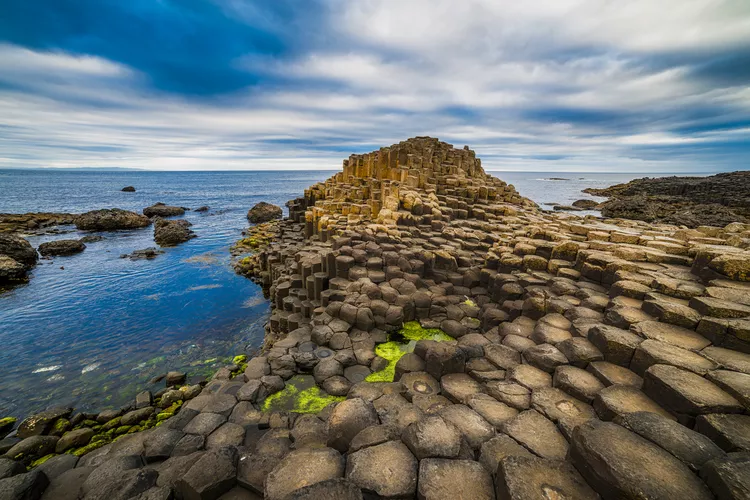1. Overview
The Antrim coast features unique and rugged beauty, with the Giant’s Causeway being the most breathtaking highlight. This natural wonder consists of 40,000 black basalt stone columns stretching along the water’s edge, attracting nearly a million visitors annually. This guide offers insight into visiting this World Heritage site.
2. History
Interest in the Giant’s Causeway peaked when it was first reported in London in 1693, following its discovery by the Bishop of Derry in 1692. Though the documented history spans just a few centuries, the Giant’s Causeway itself formed nearly 60 million years ago during significant geological shifts when Europe and North America were still connected. Massive volcanic activity created cracks in the earth’s crust, allowing lava to fill in the gaps. The unique conditions present during its formation set the Giant’s Causeway apart as the only formation of its kind worldwide.
3. The Legend of the Giant’s Causeway
Although volcanic activity is the true origin of the Giant’s Causeway, a captivating local legend attributes its creation to Fionn mac Cumhaill, or Finn McCool. Despite his relatively modest height of 52 feet and 6 inches, Finn challenged a larger Scottish giant named Benandonner. To prove their strength, Finn constructed a causeway across the Irish Sea. Exhausted from his efforts, he fell asleep, prompting his wife to disguise him as a baby when the Scottish giant arrived. Mistaking Finn’s form for that of an enormous infant, Benandonner fled, destroying the pathway in his fright, which we now know as the Giant’s Causeway.
4. What to See and Do
Visitors to the Giant’s Causeway will enjoy numerous outdoor attractions:
- Grand Causeway: The largest grouping of rock formations, showcasing the famous hexagonal basalt columns.
- Port Noffer: A picturesque bay allowing for stunning views, featuring the famed Giant’s Boot rock.
- Wishing Throne: A natural rock formation resembling a throne, perfect for photos.
- Biodiversity: The unique habitat supports an array of seabirds and plant life.
Additionally, the award-winning visitor center, designed by Heneghan Peng, offers interactive exhibits on the geology and history of the site, as well as a cozy cafeteria.
5. Location and How to Visit
Situated along the Causeway Coast in County Antrim, Northern Ireland, the Giant’s Causeway is easily accessible by car, with parking available on site. Visitors can reach the area via the B147 Causeway Road, two miles outside the village of Bushmills. Public transportation options include several bus services, and a unique experience can be had by riding the Giant’s Causeway and Bushmills Railway.
Optimal visiting times are between April and October, when the outdoor site is open from dawn to dusk. Visitors should be aware that paths may close due to inclement weather and potential landslides.
6. Accommodations
The charming Causeway Hotel, just a five-minute walk from the visitor center, offers a classic stay with modern amenities. Additionally, various bed and breakfasts in nearby Bushmills provide a cozy, town-like atmosphere.
7. What Else to Do Nearby
The Giant’s Causeway is conveniently located near the village of Bushmills, renowned for its whiskey. Visitors should explore the Old Bushmills Distillery for an inside look and tasting. Other nearby attractions include the historic Dunseverick Castle and the picturesque Dunluce Castle, famed for its dramatic coastal views. Adventurous souls can also cross the thrilling Carrick-a-Rede rope bridge, which hangs 100 feet above the ocean waves.




